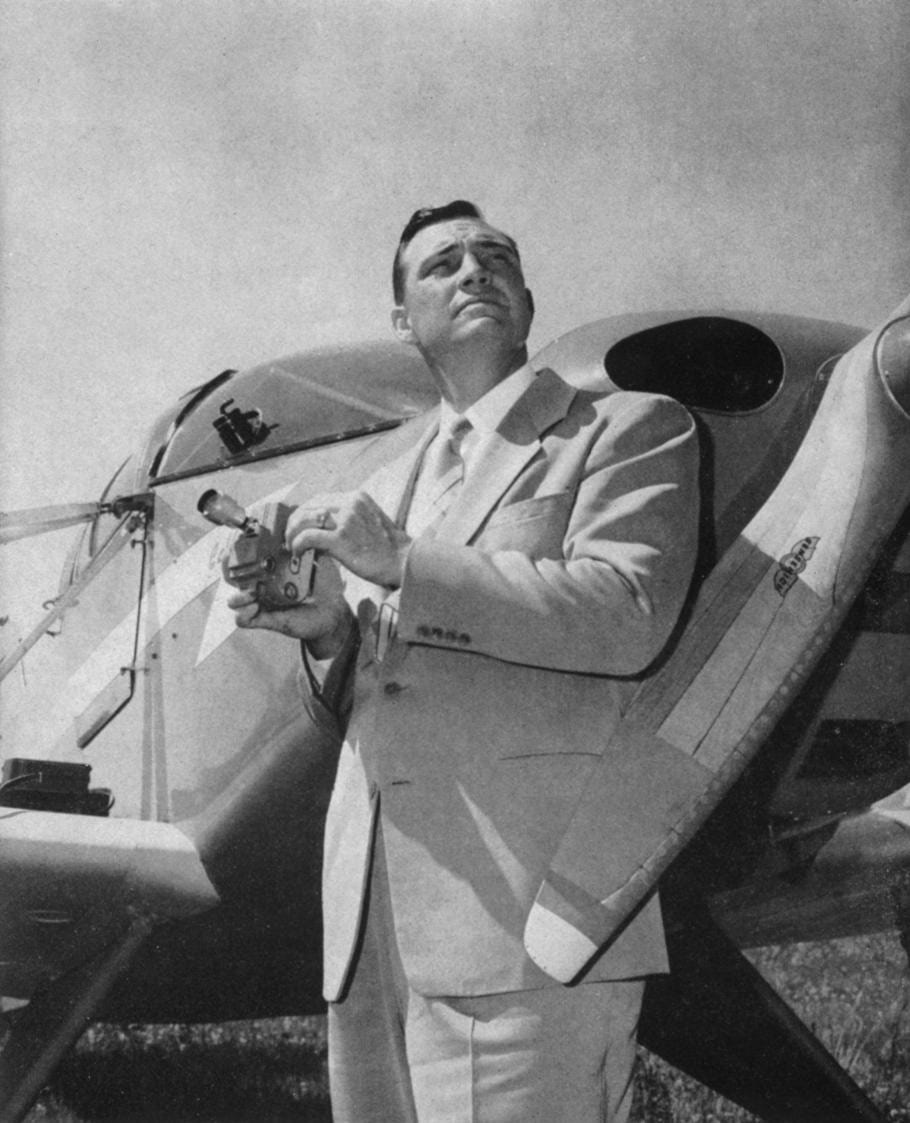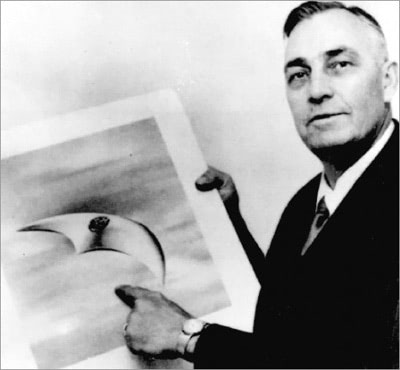
Summary
The Kenneth Arnold UAP sighting happened June 24, 1947 when private pilot Kenneth Arnold claimed that he saw a string of nine, shiny UAPs flying past Mount Rainier at speeds that Arnold estimated at a minimum of 1,200 miles an hour. Arnold’s descriptions of the objects that were flying in a “V” formation led to the coining of the phrases “flying saucer” and “flying disc,” which became popular UAP descriptors of the time.
Background
This was one of the first post-World War II sightings in the United States to garner nationwide news coverage and it is often credited as being the first of the modern era of UAP sightings. However, UAP sightings were being reported throughout the U.S. at the time.
Arnold described that he saw a bright light—just a flash with a blue-ish tinge. At first, he thought the light must have been coming from another plane, but when he looked around all he could see was a DC-4. The lights continued with nine flashes in rapid succession. Arnold estimated the time it took the objects to travel between Mount Rainier and Mount Adams, a distance of about 50 miles was just 1 minute and 42 seconds. By Arnold’s calculations, this meant that the UAPs were traveling about three times faster than any aircraft was capable of at the time.
Arnold told reporters about the “flying objects,” and described their movements like “like a saucer if you skip it across the water.”² This is where the term flying saucers is believed to have originated. A 1970 study reviewing U.S. newspaper accounts of the Arnold sighting found that the exact terminology had been introduced by an editor or headline writer.
One of the first headlines in a major U.S. newspaper came from when the Chicago Sun ran the headline “Supersonic Flying Saucers Sighted by Idaho Pilot.” As this story spread throughout America, Arnold became an accidental media sensation.
Local eyewitness testimonies corroborated Arnold’s story. One example was when The Portland Oregon Journal reported receiving a letter from a L. G. Bernier of Richland, Washington. Bernier said he saw three of the strange objects over Richland flying toward Mount Rainier about 30 minutes before Arnold’s sighting.
As numerous other sightings came in around the area around the same time of Arnold’s alleged incident, the military began to look into it. Military intelligence found a member of the Washington State forest service that reported seeing "flashes" at 3:00 p.m. over Mount Rainier, which was exactly the same time as Arnold's sighting. Also at 3:00 p.m., Sidney B. Gallagher in Washington state reported seeing nine shiny “discs” flash by.
Ten days after Arnold’s sighting, a United Airlines crew over Idaho on a trip to Seattle spotted five to nine flying disc UAPs that paced the plane for 15 minutes before suddenly disappearing.
Although Arnold was seen as a credible witness by reporters and the military officials that interviewed him, the Army Air Force's formal public conclusion was that the objects of Arnold’s sighting were due to a mirage.
The U.S. Air Force began an investigation of these reports called Operation Sign. Project Sign was succeeded in 1949 by Project Grudge, which in 1952 became Project Blue Book, the longest running of the U.S. government’s official inquiries into UAPs.
Some skeptics believed Arnold saw jet planes, while others, like noted UAP skeptic Philip J. Klass,⁴ cited an article by Keay Davidson of the San Francisco Examiner that argued that Arnold might have misidentified meteors. Harvard astronomer and UAP debunker Donald Menzel suggested that Arnold had seen clouds of snow blown from the mountains south of Mount Rainier, wave clouds, and Arnold had merely seen spots of water on his airplane's windows.
Not too long after Arnold’s sighting, the most famous UAP story in North America broke on July 8. 1947 – Roswell, which alleged military recovery of a crashed UAP, or “weather balloons.”
In 1950, Arnold was interviewed by broadcaster Edward R. Murrow. Arnold claimed since June of 1947 he had had three additional sightings of nine “spacecrafts.”

Arnold co-authored the book “The Coming of the Saucers” with science fiction magazine editor Raymond Palmer. The book was Arnold’s first-hand account of what he allegedly encountered on June 24, 1947. The book alleges that after the incident on June 24, he was being followed by the Men in Black, and he discovered that his hotel room had been bugged. The book also claims Arnold was manipulated by CIA asset Fred Lee Crisman. Arnold refers to Crisman as an eventual suspect in the JFK assassination.
Arnold met Palmer when Palmer asked him to help investigate a case in Tacoma where two men had alleged possession of UAP debris they retrieved during a UAP sighting over Maury Island in Puget Sound. Arnold interviewed Crisman, who was an associate of one of the harbor men who claimed to have UAP fragments. Arnold contacted the Air Force, and two officers soon arrived to investigate. The officers collected the alleged fragments, and took off in their plane to return to base, but the two officers died when the B-25 Bomber they were piloting crashed outside of Kelso, Washington. This incident was considered to be a hoax.
In 1962, Arnold announced plans to run for Governor of Idaho and won the Republican nomination for the 1962 Idaho lieutenant gubernatorial election, but lost to incumbent Democrat W. E. Drevlow. Two years later, he campaigned for Republican presidential nominee Barry Goldwater. Arnold even flew a plane painted with Goldwater’s 1964 slogan "Au-H2O-64".
In 1984, Arnold died at age 68 from colon cancer at Overlake Hospital in Bellevue, Washington.